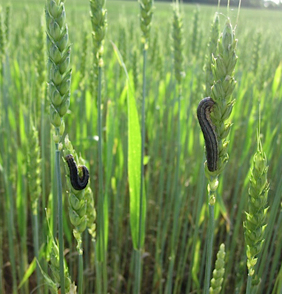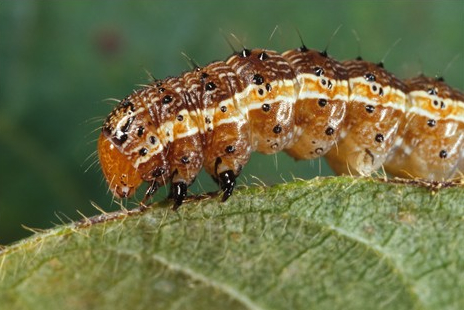Armyworms: A Wriggling Menace Takes New York
Posted in Wildlife on June 25 2012, by Matt Newman
 Live in New York City? I’ll hazard a guess you’re not starting your day with a cup of chicory and a thumb through the latest farmer’s almanac (Brooklyn’s urban agriculturists notwithstanding). But for mainland growers in the Empire State’s west end, a crawling menace on the horizon makes for an ugly forecast. Some wheat farmers are already seeing the fallout of this hungry pestilence, blown up from–where else?–the south.
Live in New York City? I’ll hazard a guess you’re not starting your day with a cup of chicory and a thumb through the latest farmer’s almanac (Brooklyn’s urban agriculturists notwithstanding). But for mainland growers in the Empire State’s west end, a crawling menace on the horizon makes for an ugly forecast. Some wheat farmers are already seeing the fallout of this hungry pestilence, blown up from–where else?–the south.
Bear with me. Being a southerner, I get free license to poke fun at the legacy.
Panicky news reports dub our attacker the “armyworm.” Technically a caterpillar, it’s the larval stage of a moth that migrates up from southern climates to lay its eggs. These guys are more or less harmless as adults. But, as infants, these wriggling brown interlopers make for a menacing monster not seen since the Biblical locusts, ganging up on fields and farmland to munch on almost anything and everything that puts down roots. When the horde exhausts the supply of green in one spot, it picks up and moves en masse to the next buffet. And the army keeps expanding. That was the case as late as 2009, when an armyworm attack on Liberian crops in Africa landed the country in a state of emergency.
The outlook is less grim here in New York. Still, the early spring paired with last month’s storm systems look to be driving what could become the worst attack in decades. Until now, armyworm infestations were relegated to the western regions of the state. Today, however, there’s a cloud hanging over the agriculture industry. Reports seeping in from the north and the east paint a picture of caterpillar populations mobilizing everywhere. All told, this could get very ugly–and the farmers aren’t the only innocents on this bug’s hit list.
Lawn-savvy suburbanites and home gardeners are advised to keep vigilant just the same. Armyworms aren’t at all picky about their snack foods, making manicured fescue turf and the back yard tomato harvest fair game.

“The armyworms have been here long enough that they’ve turned a generation or two, and they have been going after certain farm crops,” says NYBG Manager of Plant Health Don Gabel. “After doing a number on those crops, they’re now moving on to adjacent lawn areas; with this warm weather they’ll accelerate in their growth schedule while inching their way into suburbia. In fact, their numbers can become so great that they’ll sometimes cause car accidents when they cross a road en masse–running them over makes the asphalt pretty slick.”
And because they prefer to munch after dark, it’s often these crawly crooks will settle in to wreak havoc long before they’re found out. So how do you catch them early? “Start watching the birds,” Gabel recommends. “I watch what they’re pulling out of the ground, and they’re not pulling out caterpillars [around New York City] yet. Down here, we fortunately don’t have much in the way of agriculture that they could bump over from, but we may have our own little storm come along and blow them into the area.”
If luck would have it that you’ve got a worm war in your Kentucky bluegrass, fear not–there are solutions, however pesticidal.
“If you suspect the caterpillars have moved into your lawn, you can mix a tablespoon of dish soap with a gallon of water and saturate a patch of grass–just about everything hiding down there will come to the surface. But if you find you do have armyworms, it’s best to hire someone to apply the proper pesticide.”
For those preparing to brave a possible armyworm onslaught, head over to the Cornell Cooperative Extension for more information on how to fight back. Above all things, don’t ignore it! Controlling the infestation is easiest when tackled early, and sounding off might just save not only your prize-winning yard, but your neighbor’s, as well.
Field photo courtesy of the Cornell Cooperative Extension.
Armyworm close-up courtesy of Wikimedia Commons.

